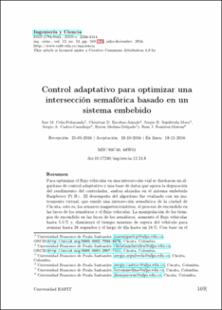Control adaptativo para optimizar una intersección semafórica basado en un sistema embebido
...
Celis-Peñaranda, Jose M | 2016-11-22
In order to optimize the traffic flow on a road intersection, an adaptive control algorithm and a data base were designed; both components were hosted on a Raspberry Pi B+ embedded system. The data base helps to debug the performance of the controller. The efficiency of the algorithm was assessed using a virtual instrument, which emulated a traffic light intersection in the city of Cucuta, i. e., the magnetorresistive sensors, the activation process of the traffic lights and the traffic flow. By processing and updating the times assigned to the traffic lights, the traffic flow was increased up to 5.5 % and the maximum time a vehicle has to wait before passing through the traffic light was decreased up to 28 seconds. Aditionally the length of line was diminished up to 18 %. Based on this case study, it can be inferred that is possible to integrate the adaptive control and the embedded systems as software and hardware tools to improve the operation of traffic control systems.
LEER










